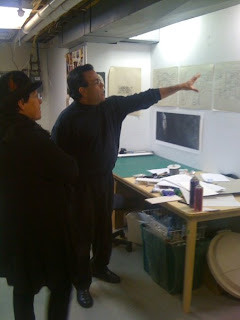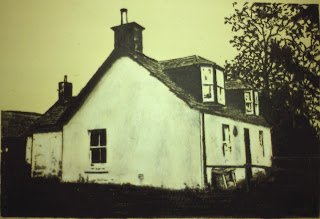Mera Rubell in my Studio (Next to the last Part)
Part I here and Part II here.
And so I was in the position where I suspect every artist on this planet would love to be: Ubercollector Mera Rubell and a small entourage were in my studio, waiting for me to show them my art work.
But I am of Cuban ancestry, so rather than showing work right away, I started talking about it.
And because I am of Cuban ancestry, before I started to talk about the artwork, I talked about what led to the artwork.
I told them that when I found out on Thursday that I had been selected to be visited by Rubell, I was ecstatic and glowing with anticipation.
And then I told them that I had immediately realized that I had no current work to show them, because all of my work is in storage in Miami waiting to be shown at the Miami International Art Fair.
"Do you know about that fair?" I asked possibly the world's leading art fair goer. She said yes.
"So I thought that maybe I could ask you to visit me at the fair and see the work." I paused, and everyone looked a little alarmed, mostly me at seeing them a little alarmed.
"You have nothing to show us?" Someone asked.
"Yes, I do." I answered. "Because what I decided to do when I realized that I had no work to show you, was to create as many drawings as I could between then and now. And so between Friday at 3:30 AM and this morning at 9:00 AM I created everything that you will see today."
Rubell looked a little amazed. "You mean that you did all the work in the last 36 hours?" She asked.
I said yes.
"You see," she turned to the entourage, suddenly filled with vigor and energy, "this is the first artist who crated new artwork just for the visit!"
"Ahhh..." I stammered a little embarrassed. "I had to! I had nothing to show you." But I was inwardly feeling that things were going well now.
"What have you got to show me?" She said, the studio suddenly bristling with her energy. "This is a dynamo in human form," I thought to myself.
And yet, I delayed a few precious moments more, and then really started talking about what drives my imagery.
I talked about how I had discovered the Picts in my childhood reading and then re-discovered them in Scotland when I lived in that breathtaking nation from 1989-1992.
I told them about the research that I had done as an amateur historian on them and their tattoos, and I showed them some examples of Pictish artwork that I had pinned to my studio wall.

In this photo by Lisa Gold, Rubell is looking at me describing the tattoo artwork of the ancient Picts, as I weave a artistic genetic line to my current work.
I described how a few years ago I had a show where it was all about Pictish art. And then I led the discussion, minutes gone by, to the trail of that artwork to my current work.
I'm a good talker, and I think that they were all interested in this historic genetic line that I was weaving. No one was yawning, and the room was still charged with electricity.
I explained how the tattoos married with my interest in narrative art, and art that tells a story or makes a point, backs up an agenda or delivers a social commentary.
And then I turned over the gigantic drawing of Che Guevara with the writing on the wall behind the Argentinean icon.

"Asere, Si o No?" 19"x48" Charcoal on PaperAs I've described before, this is a huge charcoal drawing of Ernesto "Che" Guevara de la Serna Lynch. Che is to the left in a very Christ-like pose. behind him, a slogan or graffiti on the wall asks the question in Cuban slang:
"Asere, Si o No?" which means "Friend, Yes or No? The capital letters answer the question by spelling out ASESINO or assasin. I explained all these Cuban nuances to the Spanish language and my agenda behind it.
"You did this in the last 36 hours?" Someone asked a little quizzical.
"You see!, You see!" beamed Rubell, this is what I'm all about!" she gestured at the piece as I discussed my historical affinity to Che Guevara, both as a hero to some and as a mass murderer and racist to others. Rubell noted that I had captured a strong sense of the zealous Maoist in his eyes and face.
"What else is there?"
The next few pieces went fast. With each I explained what the drawing was all about. I discussed the intimacy of drawing the viewer close. I discussed humor in art when I showed them the Superman drawing. I discussed being very tired and possibly hallucinating when I did the "Fuck Elections" Obama drawing. I discussed the nuance of words when I showed them the "Age of Obama - Nobel Peace Prize" drawing.
"Is that Catherine Opie?" Asked Rubell when she looked at "True Believer." I told her no (the model is actually a local Sunday School teacher). "She really looks like Catherine Opie!" she commented. Note to self: contact Catherine Opie and see what she thinks of the likeness.
I was in a groove, and I can't remember why, but there was a lot of laughter all the time. I think that I asked them if they were laughing so much because they were delirious from lack of sleep. They exploded in laughter at that. I laughed too, because I was indeed super tired from the last 36 hours, but I was also feeling quite on track.
I could sense that Rubell really liked my drawings, but that she also liked the reason for them, the "why I draw this" idea. Somewhere in there I talked about conceptual art and how often the idea is more interesting than the final product and people agreed with me.
More talking, more good vibes.
"Awright," she says, "can you step out for a minute?"
I leave them and go upstairs. "How's it going?" asks my wife.
"I think it's going great," I answer as a series of raucous laughter blasts emanate from the basement. My wife, Little Junes and I look at each other and wait.
An eternity goes by before I am called down to the basement.
"We were wondering," says Rubell with a devilish look in her eyes - this woman is not tired, at least not now, after a grueling 36 hours marathon of studio visits; that much is clear to the most casual observer.
"We were wondering if..." she pauses, "considering that you were a Naval intelligence officer... if you had done some intelligence preparations ahead of time and had all these drawings in your flat files and just pulled them out just before we came?"
I could see a glint of devilishness in her eyes and I wasn't really worried that they thought that was the case, and so I easily denied the issue. Nothing like having the truth on your side.
"Raise your right hand!" ordered Rubell, her Russian-ness suddenly coming to the front. I did.
Next I was made to swear that all the work had been created in the last 36 hours, while Jennie Yang recorded the event with her camera. For a moment there I flashed back to my days in the Navy, with the myriads of re-enlistments and ceremonies where oaths are taken.
But I was in a good place, and my tired bones and eyes were testament to the truth of my creation of these works in the last 36 hours. The swearing was easy, with the relaxing backing of the truth.
We all filed out of the studio. On the way out she looked at a handmade Valentine Day's card from my wife that I pinned by the door. "This is a love nest," she stated, "another love nest..."
"We'll let you know soon," said the WPA's Lisa Gold, efficient and precise to the last minute, and reading my mind as it wondered "Am I in?"
We got upstairs, and started to say goodbyes... it all felt good. And at this point I was just glad that this electrical woman had decided to work her
tuchus off and charge up the artists of the DC area.
"So what do you think of the Washington art scene?" asked Mera as she prepared to leave the house.
She turned and looked at me, and I began to answer her.
More tomorrow...



















